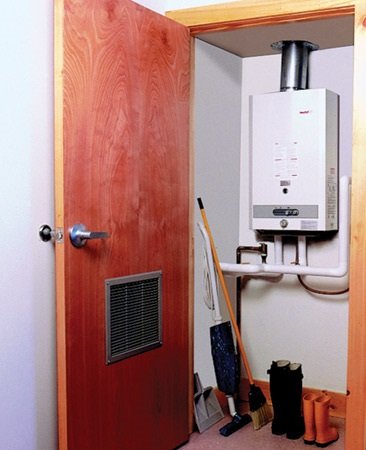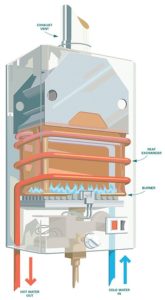The Pros & Cons of a Tankles Water Heater
Dec 08, 2014
Tankless water heater mounts on the wall.
Smaller tankless water heaters take up very little space.
Photo Courtesy of Bosch Water Heating
A tankless water heaters uses 30 to 50 percent less energy than units with tanks, saving a typical family about $100 or more per year, depending on water usage. Tankless units (also called “on demand” units) heat water only when you turn on the faucet. They usually operate on natural gas or propane. The main advantage is that they eliminate the extra cost of keeping 40 to 50 gallons of water hot in a storage tank, so you waste less energy. They also offer a continuous supply of hot water, which is ideal for filling a big hot tub or a whirlpool. They’re more compact than a standard water heater and mount on a wall.
The primary disadvantage is the upfront cost. The smaller units that you often see won’t produce enough hot water to serve most households. They’ll only serve one faucet at a time—a problem if you want to shower while the dishwasher is running. Larger units that can handle the demand of a whole family, but are expensive.
But because tankless units have high-powered burners, they also have special venting requirements (a dedicated, sealed vent system, which requires professional installation). Natural gas burners often need a larger diameter gas pipe, which adds to the initial installation cost.
The bottom line: When you’re pricing a unit, be sure to get an estimate or firm bid on installation costs. This is not a do-it yourself project unless you have pro-level skills. You can find tankless water heaters at many home centers and plumbing specialty stores.
Figure A: Tankless Water Heater Details
When a hot water tap is opened, the heating elements turn on. Water is heated as it flows through the heat exchanger.

Artwork Courtesy of Bosch Water Heating
Figure A: Tankless water heater details
If you’re considering making the switch to a tankless water heater, you should carefully weigh the pros and cons first.
Benefits:
- Most tankless units come with a federal tax rebate of $300.
- They never run out of hot water.
- They last five to 10 years longer than tank heaters.
- They’re more efficient with no standby heat loss.
- They take up less space and can even be installed on walls or outdoors with an anti-freeze kit.
- Smaller units can be installed under cabinets or in a closet, closer to the point of use.
- They only need enough power to heat the amount of water necessary at any given moment.
- You can shave as much as 20 percent from your water heating bill.
- Electric models don’t produce greenhouse gases
- Most units are operated by remote control and have up to four separate settings available.
- There’s no possibility of flooding due to a ruptured tank.
Drawbacks:
- They cost up to three times as much as a tank water heater.
- Your hot water output is split among all your household fixtures.
- You may need to add a larger natural gas line to supply the unit with enough fuel.
- Venting gas and propane units requires expensive stainless steel tubing.
- Electric models may require an additional circuit.
- Gas-powered units produce greenhouse gases.
- Gas units require the additional expense of an annual servicing.
- Electric models require a lot of energy.
- They need a minimum flow rate of .5 GPM in order to activate the heat exchanger.
- Lag time can require you to run your water in order to get to the hot water, increasing water waste.
Other Considerations:
- Water heating accounts for about 20 percent of your home energy budget.
- A whole-house electric model costs $500-$700.
- A whole-house gas model costs $1,000-$2,000.
- Electric models are generally cheaper to install than gas.
- Natural gas is less expensive now, but expected to surpass electricity in the coming years.
- A standard bathtub holds about 35 gallons, soaking tubs hold between 45-80 gallons.
If it’s time to get a new water heater and you want to know if switching to a tankless unit will save you money in the long run, compare the yellow “Energy Guide” stickers on your current heater and the tankless model that best suits your needs. This sticker will give you a good idea of what you can expect. Then weigh in all the expense factors that come with going tankless, including venting costs and gas line or electricity upgrades. Once you know the total costs involved, compare this to the cost of a new tank model and then figure out your energy costs for each. The amount of time it will take to make back your money with your monthly savings is called the payback period. You should also consider that a storage tank heater will need to be replaced again in about ten years — you’ll get roughly 15-20 years of use from your tankless model.

